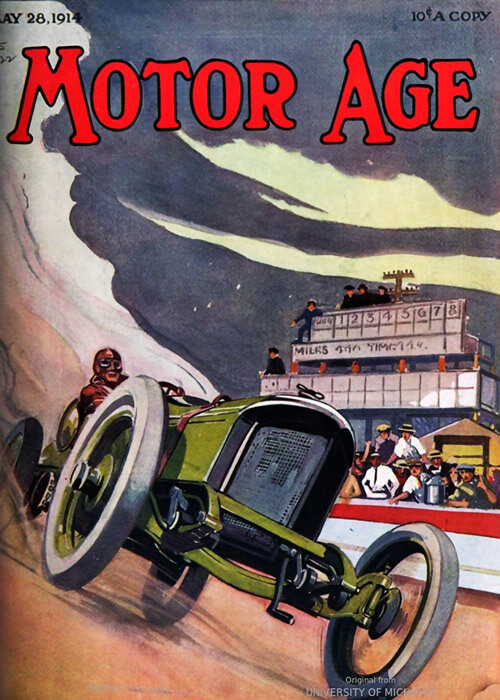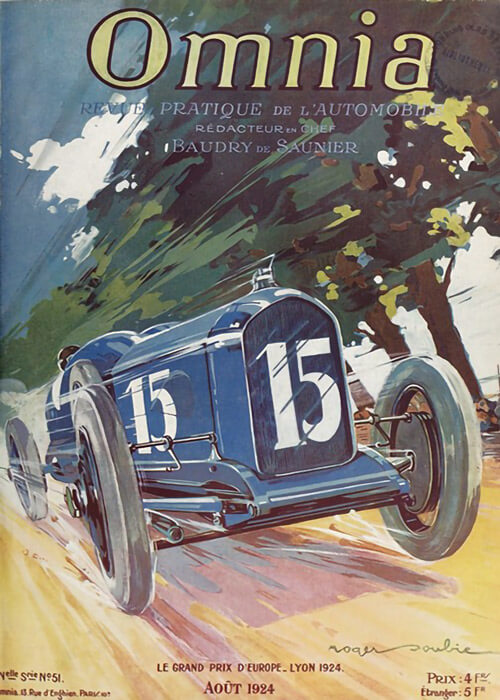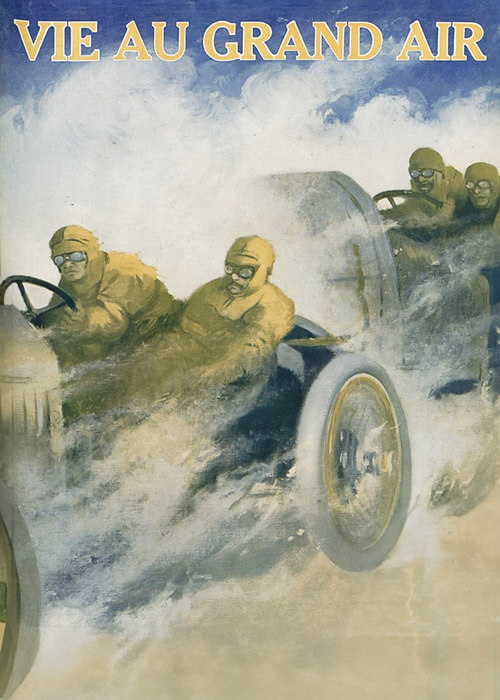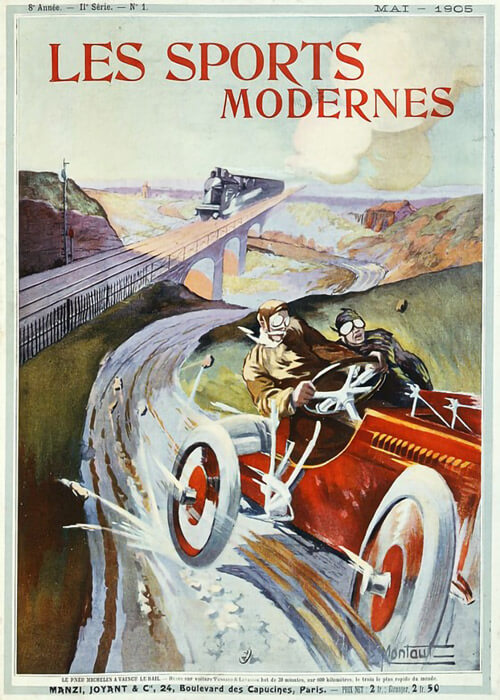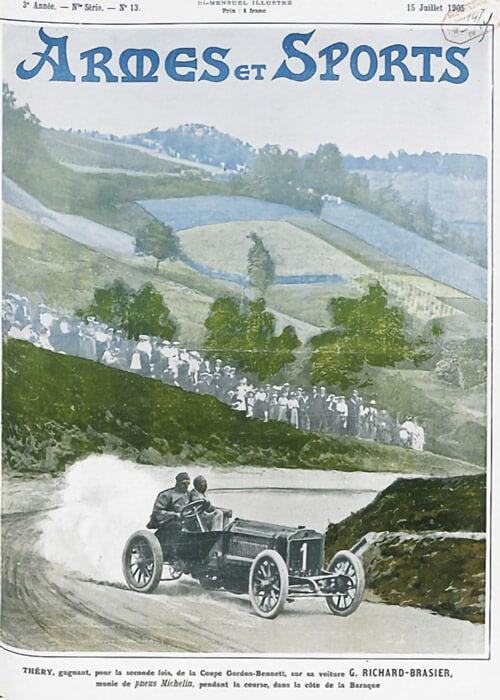The first series of races on the new Indianapolis Motor Speedway, three days in August 1909, resulted in mere catastophy. The driver William A. Bourque and his mechanic, Harry Holcomb were killed during Thursday’s 250-mile race for the Prest-O-Lite Trophy. Then on Saturday, in the Wheeler & Schebler 300-mile race, Merz‘ National car ran over the bank, killing his mechanic Kellum and two spectators. After that, the race was called off.
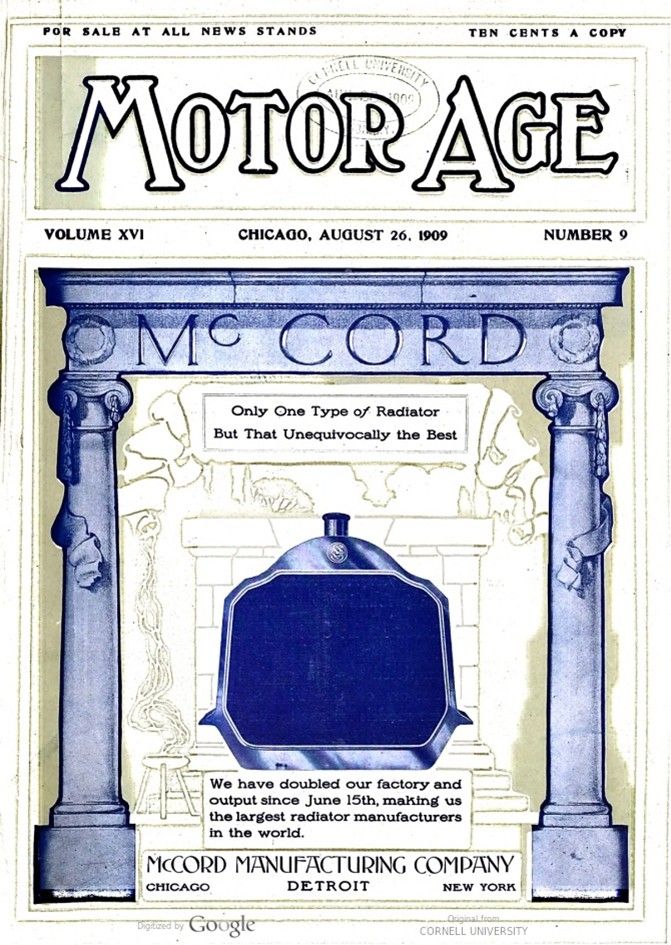



Text and jpegs by courtesy of hathitrust.org www.hathitrust.org, compiled by motorracinghistory.com
Motor Age Volume XVI, No. 9, August 26, 1909.
SPEEDWAY CREATES A NEW RECORD TABLE
INDIANAPOLIS, Ind., Aug. 24 – America’s new motoring era has been opened and racing in this country is being revolutionized through the enterprise of Carl Fisher, A. C. Newby, F. H. Wheeler and J. A. Allison, who have enough confidence in the sport to invest $400,000 in a speedway which is devoted to motoring interests, which was thrown open to the public last week when the first meet was run Thursday, Friday and Saturday, which resulted in the demonstration that at last those who are devotees to the Goddess of Speed have a proper shrine at which to worship. The 3 days of sport resulted in a shattering of records that has made a new slate. Of course it is hard to compare these marks with previous ones, for heretofore American track records have been established on tracks built for horse racing and entirely inadequate for motor racing.
Indianapolis starts the ball rolling with some marks that will stand for some time. Every one of the standard distances was cut and in one instance an Ormond record went by the board. Thirty-seven times the cars that were clocked eclipsed previous records. In the case of the 100-mile all nine cars timed beat it, as also was the case in the 200-mile. This fattened the prestige of eight different makes of cars, the Buick, National, Chadwick, Benz, Fiat, Jackson, Marmon and Stoddard-Dayton.
It must be admitted that the surface of the track was not in the best possible condition, but then there are extenuating circumstances. From the time work on the speedway started last spring up to the first of this month Engineer Andrews was greatly handicapped by the rainy weather and it only was by working night and day the last 2 weeks that he was able to complete the circuit. Possibly it would have been better to have postponed the meet, but this was not done and so another chapter of motoring history was written.
Competition Is Keen
So far as the racing itself was concerned, the sport was interesting and exciting. With a 4-mile straightaway in which to finish and with turns so easy that they were hardly noticeable it was possible to have some real competition. On an ordinary track it is seldom the spectators enjoy close finishes and it is still more rare to see a car be able to master up a sprint at the end. But at Indianapolis last week there were several in- stances of this, much to the enjoyment of the public.
Better support never was given by this same public and the first meet shows a big profit on the right side of the ledger – possibly $50,000. It cost about $10,000 to stage the affair and Director Moross stated Saturday that his gross receipts ran over $60,000. The first day brought out a crowd of 15,000, big enough to satisfy most promoters. The second day there were 22,000 in the stands and on Saturday, the last day, the grounds were packed, it being estimated that there were at least 40,000 in the stands and scattered around the park. The organization by which these crowds were handled seemed perfect. There was little confusion noted and the stands seemed to fill as if by magic. Even though the racing started at noon each day the people managed somehow to be there in time and on Saturday, when the card opened at 11:30, all the seats were gone at that hour.
The transportation problem seems to have been solved. There was an excellent railroad service which brought the people out in 15 minutes from the city, while the trolley lines negotiated it in Thousands drove out in motor cars and yet the road leading to the park never seemed congested even when returning at night.
The speedway received magnificent support from surrounding cities. Chicago, usually decidedly clammy, must have sent at least 1,000 to Indianapolis. A tour to the meet was organized and some fifty or sixty cars made the trip last Wednesday. Dayton, where the Stoddard-Dayton car is manufactured, sent over one train load of 2,500 people. Arrangements had been made to transport 500 of the Stoddard-Dayton workmen over in a special train, but when it carne time to start, it was discovered that 2,500 people had gathered for the trip, so it was necessary to add more cars.
Officials Are Competent
The officials selected to handle the meet did their work well and there was no hitch in the running of the races, no weary wait or wrangle. Hardly would one race finish before the cars in the next one would be lining up and it was nothing unusual to see Starter Wagner about to fire his gun before the winner of the preceding race had a chance to get off the track. The timing system which was used at the meet worked to perfection and the people knew the winners and the time be: fore the cheers had died out.
Fatalities of the Meet
The one black cloud on the meet was the death list that resulted because of accidents on Thursday and again on Saturday. In the 250-mile race for the Prest-O-Lite trophy William A. Bourque and his mechanic, Harry Holcomb, the Knox crew, were killed, just how no one knows, for neither lived long enough to tell. It was after 200 miles had been covered. Bourque had gradually climbed into a good position and he was looked upon as a possible winner. He had turned into the stretch after a brush with Chevrolet and it is said he and his mechanic had looked around at the same time. Why they did no one knows, and the next instant there was an upset, the Knox turned turtle and the two men were in a dying condition. Something had given away in front and the front axle was detached from the car, which was in a wrecked condition. Poor Bourque and Holcomb died in a short time.
Friday’s racing was run off without a mishap worth mentioning and it looked up to late Saturday afternoon as if the meet would wind up without any more accidents. Then came the Merz trouble, Merz‘ National, in the Wheeler & Schebler 300-mile race, running over the bank, Kellum, the mechanic, and two spectators being killed. A few minutes after Keene, driving a Marmon, ran into a fence, being slightly injured himself, and his mechanic suffering from a fractured skull, which is not expected to prove fatal. It is said that Keene was asleep at the time, but this fact has not been proven. This accident occurred near the bridge crossing the track near the bleachers and following it the referee decided to call the race off, although it had only reached the 235th mile.
Will Spend Another $100,000
Since the meet there has been an outcry from the public which seems inclined to blame the speedway for the deaths, and heeding this the promoters have determined to do everything in their power to make the plant safe. A meeting was held this morning at which an additional $100,000 was subscribed to put the track in absolutely safe condition and to build safeguards for the drivers and the public. There is talk also of revising the rules which will forbid a driver going more than 100 miles without rest and it is even suggested that there be a 10-minute intermission in the long races to be devoted to the examination of the cars themselves. Also it is planned to compel drivers to change their tires after a certain number of miles.
All this talk, however, does not make the critics believe that the speedway can be blamed. Those who have had years of experience in racing believe that the track is perfectly safe and constructed on the right lines. They admit that during the meet the surface was somewhat rough, but still they think that Engineer Andrews has done his work well and produced a circuit which is capable of almost any speed and safe at any spot on the track. Many blame the drivers themselves for the accidents, asserting that if the physical condition of the pilots had been inquired into it would have been found that the men did not have the necessary strength to go through such rigorous tests.
Drivers Overworked
With five and six events carded each day and with one of them always a long distance trial, the drivers were over-ambitious, Many of them would drive in two, three and sometimes four races a day. Then, to make matters worse, they would drive 50 and 60 miles a day in the morning tuning up their cars for the racing in the afternoon. Often, too, it was necessary to work most of the night, so that some of the pilots found themselves in a weakened condition when it came to the actual racing itself. In that condition it was little wonder that accidents should occur.
In the case of Bourque, that driver had been through a long and rigorous campaign this summer and his physical condition is said to have been none of the best when he came to the speedway for the meet. At the time of his accident he had driven 200 miles in a race which was exciting and strenuous. Merz, too, had been driving hard for several days and he, too, was past the 200-mile mark when he went over the bank.
Jackson Enters Protest
Since the decision handed down by Referee Stevens in the Wheeler & Schebler race there has been considerable complaint made by those whose chances of winning were good. The Jackson people intend making a fight for the cup and today they gave notice of their intention of appealing to the American Automobile Association, asserting that when the race was stopped after 235 miles had been completed the Jackson, driven by Lynch, had a comfortable lead and seemed certain to win. Closest to him was de Palma in the Fiat, but he had stopped at the pit to repair a spring and the Jackson had improved the opportunity to pick up a couple of laps on him. There is some talk of running for the cup at the next meet, which has been arranged for next month, when a 24-hour race will be put on, with a big field promised.
